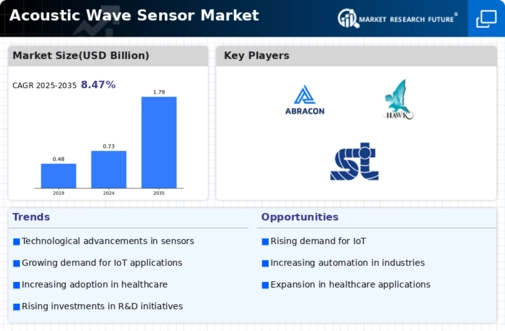Top Industry Leaders in the Acoustic Wave Sensor Market

Competitive Landscape of the Acoustic Wave Sensor Market
The acoustic wave sensor market is resonating with immense potential across diverse industries. These versatile sensors, utilizing mechanical acoustic waves to detect changes in frequency, amplitude, and phase, are driving innovation in applications ranging from automotive safety to healthcare diagnostics. Understanding the competitive landscape of this dynamic market is crucial for stakeholders seeking to capitalize on its growth trajectory.
Key Player:
- API Technologies Corp
- Vectron International
- A D Metro Inc.
- Qualtre Inc.
- Abracon LLC
- Hawk Measurement System
- Sensor Technology Ltd.
- NanoTemper Technologies GmbH
- Althen GmbH
Strategies Adopted by Leaders:
- Technology Prowess: Infineon Technologies and Broadcom Inc. lead the charge with high-performance, miniaturized sensors and advanced software algorithms, setting the benchmark for accuracy, sensitivity, and reliability.
- Vertical Specialization: SensiTech focuses on environmental monitoring applications, while Murata Manufacturing targets the automotive industry with sensor solutions for collision avoidance and lane departure warning systems.
- Partnership Play: Texas Instruments collaborates with universities and research institutions to develop novel materials and sensing techniques, fostering co-development and staying ahead of the curve.
- Cost Competitiveness: Microchip Technology prioritizes affordability and offers entry-level sensor solutions, catering to cost-sensitive segments, particularly in emerging markets.
- Open-Source Platforms: Silicon Labs promotes open-source software tools for developing acoustic wave sensor applications, empowering developers and accelerating innovation in the ecosystem.
Factors for Market Share Analysis:
- Technological Leadership: Companies offering superior sensitivity, wider detection range, and improved data analysis capabilities command premium prices and secure market share.
- Integration and Compatibility: Seamless integration with existing infrastructure and compatibility with various devices and operating systems are essential for widespread adoption.
- Form Factor and Size: Miniaturization and ability to integrate sensors into small devices without compromising performance are crucial for diverse applications.
- Power Consumption and Efficiency: Low-power consumption and long battery life are critical for battery-powered devices and mobile applications.
- Regulatory Landscape: Navigating compliance with safety regulations and environmental standards in different regions is crucial for market access and global expansion.
New and Emerging Companies:
- Startups like SensiQ Technologies and Chirp Microsystems: These innovators focus on niche applications like gesture recognition and medical diagnostics, pushing the boundaries of sensor capabilities and unlocking new potential.
- Academia and Research Labs: MIT's Microsystems Technology Laboratories and Stanford University's Sensor Actuator Center explore novel materials and detection techniques, shaping the future of acoustic wave sensor technology.
- Material Science Players: Companies like Corning and Kyocera develop advanced materials for piezoelectric and MEMS platforms, influencing core technologies and affordability in the market.
Industry Developments:
Panasonic Industry Co., Ltd.:
- Dec 2023: Announced a new series of ultra-miniature acoustic wave sensors for wearables and IoT devices.
- Jun 2023: Collaborated with a research institute to develop next-generation acoustic wave sensor materials with improved sensitivity and performance.
TDK Corporation:
- Dec 2023: Launched ultra-high-voltage acoustic wave sensors for monitoring power grids and improving energy efficiency.
- Sep 2023: Acquired EPCOS AG, expanding its portfolio of acoustic wave sensors for automotive and industrial applications.
